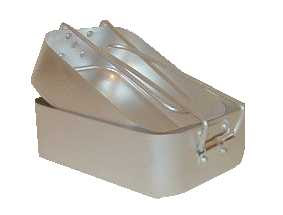Many people interested in survival or bushcraft tend to take their cues from the military.
When it comes to field cooking, the circumstances of the solitary traveller are rather different from those of a soldier.
For many armies the mess kit has cooking as only a secondary function. Meals are prepared by a field kitchen or catering unit, and the mess kit is mainly used to receive the finished product.
Since World War Two, the use of ration packs has become widespread and mess tins are mainly used for warming up the precooked items.
Modern soldiers make much less use of mess kits than previous generations.
Nowadays MREs are supplied with flameless cooking pouches, so many troops in the field do not carry any cooking equipment other than a canteen cup.
Larger field catering units often use disposable tableware instead.

The Germans, Russians and a number of other armies have issued a mess kit that looks a little like a binoculars case. In fact, as a boy I thought these items on my toy soldiers were packed field glasses!
The basic item has an oval or kidney-shaped cross section.
The bottom part is a deep pot, often provided with a bail handle. The lid is deep enough to also serve as a cooking vessel and provided with a folding side handle. It is neither pot nor frying pan really but makes a reasonable (if unconventionally shaped) cup.
Such mess kits formed a compact package that could be carried in a pack or pouch or attached directly to a belt or the outside of a knapsack.
Some versions have other components such as dishes or bowls that fit inside.
The German water canteen fitted inside a pair of aluminium cups of similar design to the mess kit.
To put these kits in context, they were often used in conjunction with field kitchens, and some soldiers of previous generations had more modest expectations when it came to food. If they got hot soup, coffee and fresh bread they considered themselves well off!
A small field kitchen such as the German horse-drawn models widely used in both wars had an oven and two big boiling vessels. One for coffee and the other for a hearty soup, stew or pasta dish.
A mess tin bottom full of soup and the lid filled with hot coffee was just what a fighting man wanted.

Two variants of this basic pattern are deserve a special mention.
The first is the Swedish Army Mess Kit.
This has an oval section billy for the bottom and a lid that also serves as a pan.
Lid capacity is about 550 mls, the lower section holds 1.3 litres.
The handle of the lid has two folding rings of an arch-shape. A stick can be inserted through these if you need a longer handle or one that will not conduct heat.
The Swedish Mess Kit comes with its own stove. This is a sturdy windshield that fits over the outside of the packed mess kit. Inside it at two folding pot supports and the kit also includes a spirit burner of similar design to that used on Trangia stoves.
The stove could also be used with other heat sources such as hexamine blocks, alcohol gel or natural fuel such as woodchips and pinecones.
The kit is completed by a plastic bottle marked with the Swedish triple crowns and the legend “RÖDSPRIT ELDFARLIG GIFTIG” (Methylated Spirit Inflammable Toxic). The bottle is of a size that it conveniently fits inside the mess kit but this practice is not recommended since leaks will contaminate your cooking vessels.
Keep your fuel bottle elsewhere and fill the interior of the mess kit with a brick of Supernoodles, some Oxo cubes, teabags etc.
I have used my Swedish Mess Kit several times. It is of a size and shape convenient to carry in a daysac.
If anything, it could be a little smaller. When you are hiking and the snow is on the ground it is been nice to stop and quickly heat up a quick hot snack of instant noodles.

The third kit I will discuss today is usually marketed as a Yugoslavian mess kit or “Eight piece” mess kit.
This differs from those of other armies in that the lower metal pot has a side handle rather than a bail.
The upper part is made from plastic so is more of a rectangular section bowl than a cooking vessel. The bowl is designed so that it slots onto a hook on the end of the handle, allowing both containers to be held in one hand.
Such arrangements are seen in a number of other mess kits and are intended to make handling the kit easier when queuing in a mess line.
The interior of the Yugoslav mess kit is used to store a plastic water bottle, which comes with its own rectangular beaker that fits over the top.
The final components are a carrying pouch and a metal knife, fork and spoon(KFS) set. The spoon and fork store in the handle of the knife. The knife also has a bottle opener cutout.
These Yugoslavian kits can be found at very reasonable prices. You only get one cooking vessel, but it is generously sized.
A detachable billy handle could probably be made by drilling holes near the rim at the point of balance.
I intend to acquire one of these kits soon so expect a more in depth review.
If nothing else the kits seems a good source of components that can be incorporated into a larger kit. Some camping KFS sets or water bottles cost more than this entire kit!